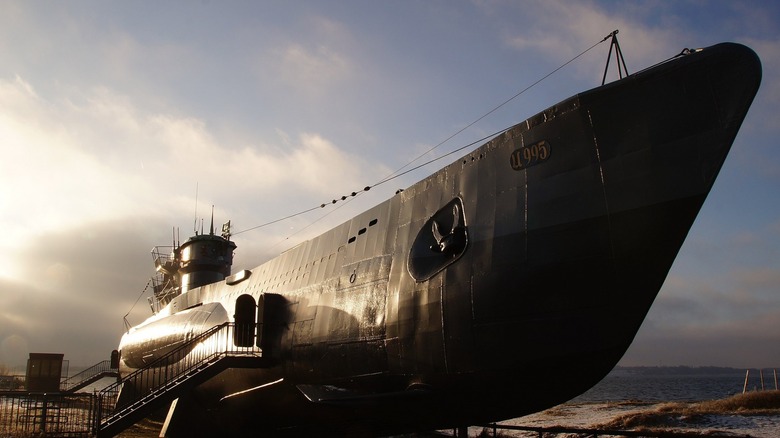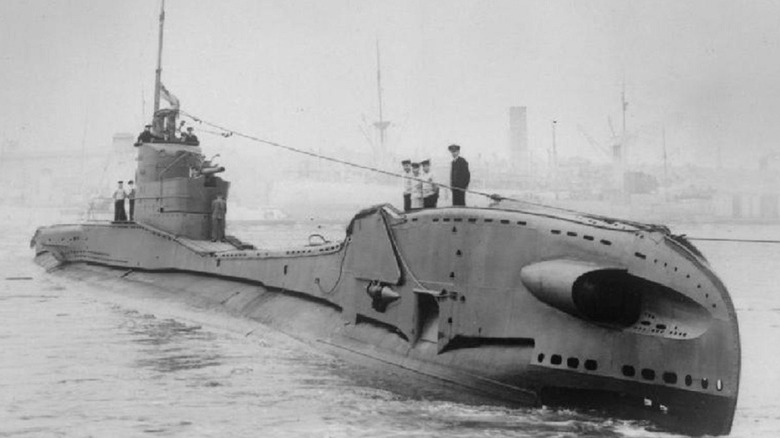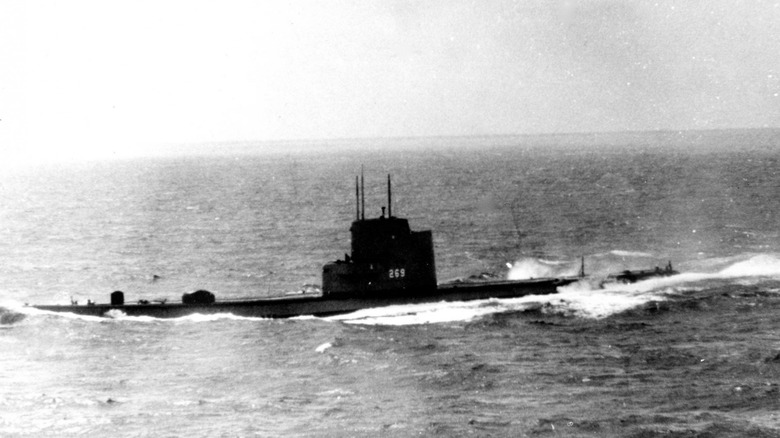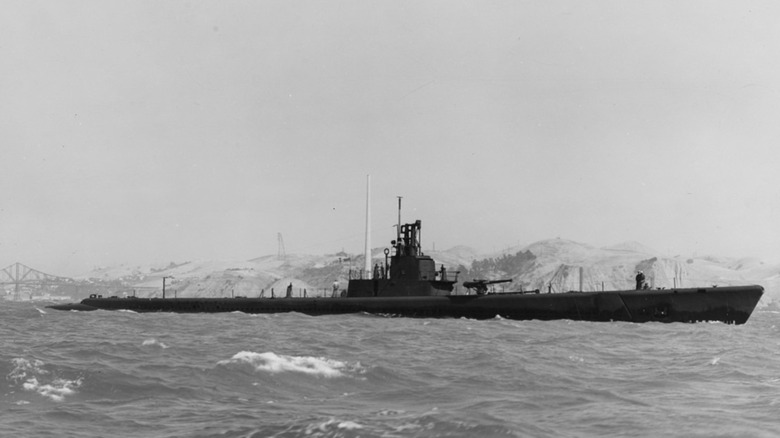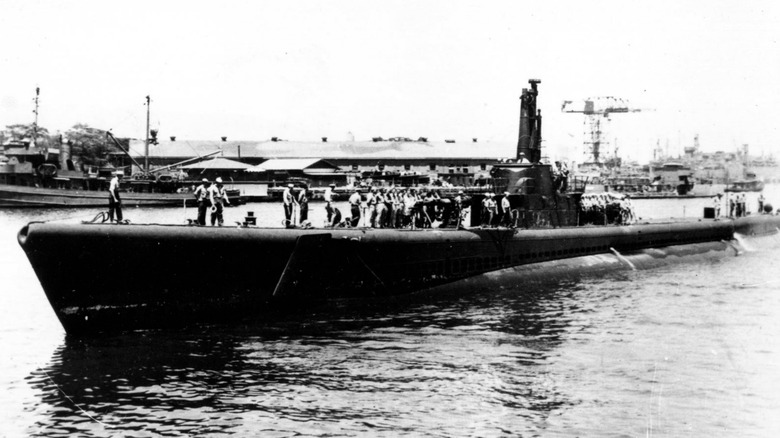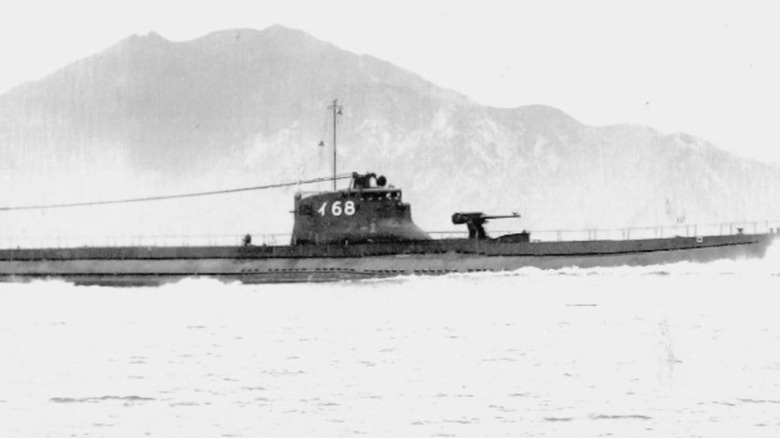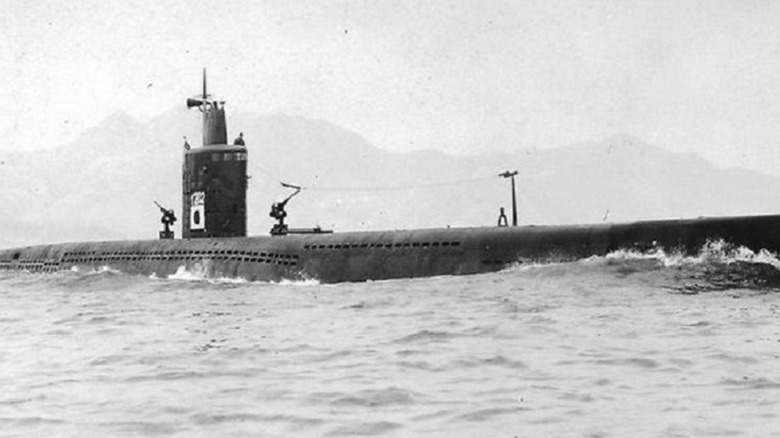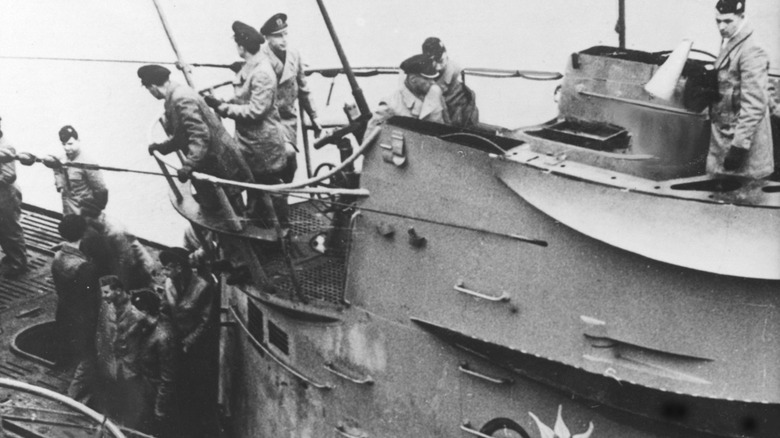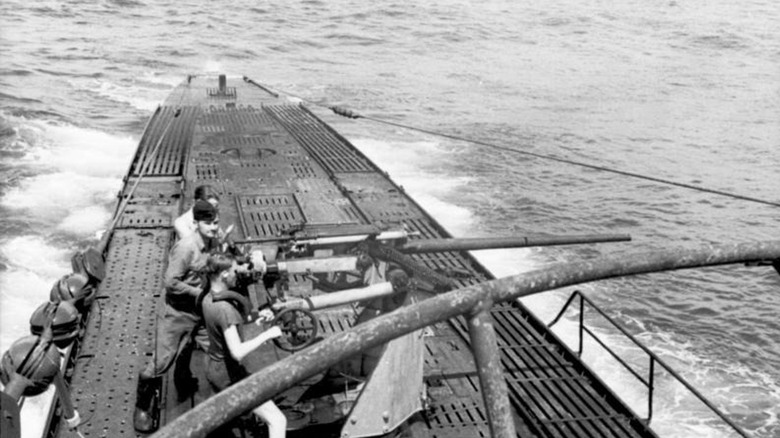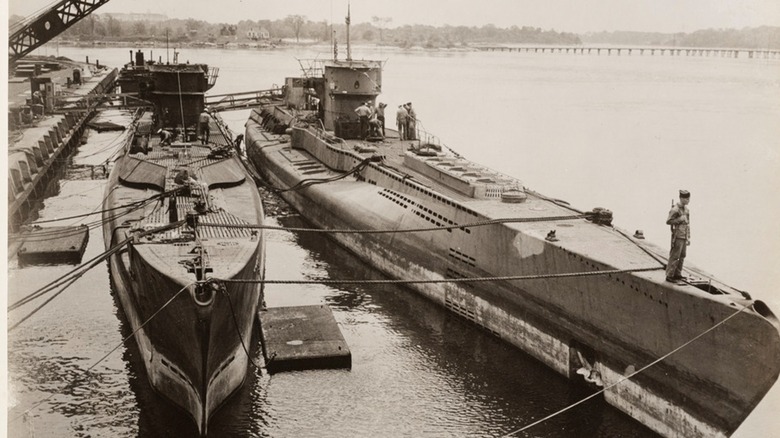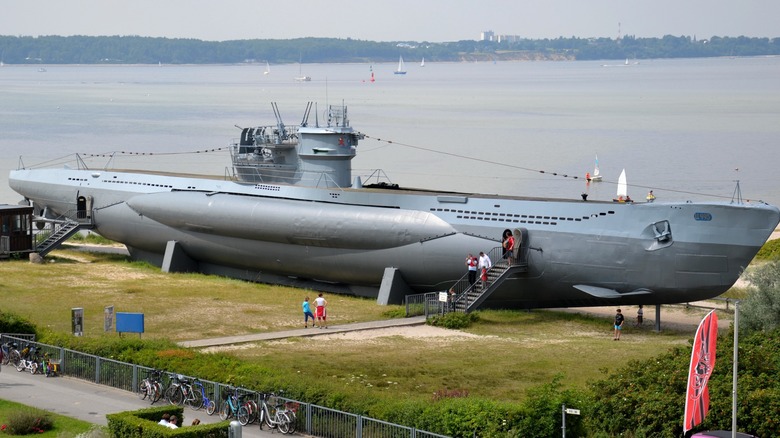The 10 Most Legendary Submarines Of WW2 Ranked From Worst To Best
The submarine is perhaps the most effective ocean-going craft for defeating naval vessels, and it was one of the most feared and revered weapons of World War II. While several countries built and employed submarines during the war, Germany, Italy, Japan, the United States, the United Kingdom, and the Soviet Union had the most success.
The torpedo is the weapon that makes the submarine such a potent war asset. During World War II, a typical torpedo was an intelligent missile weighing about 3,000 pounds, with a range of roughly 4 miles (6.4 kilometers). The self-propelled and self-guided underwater explosive device used a gyroscope-based control system to ensure a straight course and was propelled by steam or electric power (in the later years of the war). WWII torpedoes typically carried about 500 pounds of TNT and were detonated either upon striking the target or by the detection of the target ship hull's magnetic field.
The submarine played a decisive role during WWII. Both Germany and Japan fielded large and effective submarine fleets. The Japanese I-boats were active mostly in the Pacific, where they inflicted heavy losses on their enemies, mainly the U.S. Navy. However, it was the German Type VII U-boat that reigned supreme in countless encounters, particularly in the Atlantic Theater. Germany sent over 1,000 U-boats on patrols (Feindfahrten), sinking over 2,700 Allied ships during the conflict. Here are some of the most legendary submarines of World War II, ranked from worst to best.
[Featured image by Ralf Stöcker via Wikimedia Commons | Cropped and scaled | CC BY-SA 4.0]
10. United Kingdom T-Class Submarine
During the 1930s, the Admiralty of Great Britain decided to replace the existing overseas patrol submarines of the Oberon, Parthian, and Rainbow classes, which had performed poorly. Despite the emphasis placed by the Royal Navy on surface vessels, construction began in 1934-35 on the Royal Navy's T Class (or Triton Class) of diesel-electric submarines.
These new submarines were subjected to strict design guidelines. They required a strong armament and a patrol duration of at least 42 days for long-distance service. In addition, they were limited by the London Naval Treaty to a total of 16,500 tons of new construction. The Admiralty built 53 new subs with a displacement of about 1,575 tons each just before and during World War II.
The first T-class subs were 275 feet long and built with a distinctive bulbous bow to accommodate the external forward torpedo tubes. However, the bow shape adversely affected the speed while surfaced, prompting the Admiralty to build nine slightly modified T-class submarines with a more streamlined bow shape and the external bow tubes moved further back.
Although the T-class submarines achieved acceptable success against enemy subs during the war, sinking 13 enemy submarines including six Italian, four German, and three Japanese, the record is marred by an early disastrous incident. In September 1939, the crew of the HMS Triton sighted another submarine just off the coast of Norway. When the boat did not respond to radio communications, the Triton fired two torpedoes and sank the first British submarine lost during WWII, the HMS Oxley.
[Featured image by Stewart Bale Ltd via Wikimedia Commons | Cropped and scaled | CC Public Domain]
9. USS Rasher (SS 269) Gato Class
Submarines play a significant role in limiting enemy naval operations. During World War II, U.S. Navy submarines made up only two percent of the ocean-going fleet but were responsible for sinking more than 30 percent of the Japanese Navy vessels. Perhaps most impressively, eight of those ships were aircraft carriers. The American submarine success rate in the Pacific during the war resulted in the loss of nearly five million tons of Japanese merchant marine shipping.
The Gato-class submarines, consisting of 54 submarines first launched in August 1941 with the SS-212, made the most significant contribution during the early years. The fleet was later enhanced with the addition of 122 Balao-class subs boasting a thicker pressure hull for increased operating depth. While the USS Rasher is at the bottom of the list of World War II submarines as one of the least effective, the vessel still has an impressive record. The diesel submarine is credited with sinking 18 ships totaling 99,901 tons during the war.
The Gato-class submarine measured 311 feet long with a beam of 27 feet, 3 inches, and a draft of 16 feet, 10 inches. Diesel engines powered the submarine to 20 knots when surfaced, and electric motors provided power for a maximum velocity of 9 knots when submerged. The Rasher was armed with one 50-caliber gun measuring three, four, or five inches in diameter, six bow and four stern torpedo tubes, and 24 21-inch torpedoes. For its exceptional service during World War II, the USS Rasher was awarded four Presidential Unit Citations for outstanding performance in combat patrols and seven battle stars.
8. USS Wahoo (SS-238) Gato Class
The USS Wahoo outgunned the USS Rasher by two enemy ships (20 in total), but it was better known for its skippers. Lt. Commander Dudley W. Morton and executive officer Lt. Richard H. O'Kane were remembered by World War II survivors as "innovative, daring, and successful."
Commissioned on May 15, 1942, shortly after the surprise Japanese attack on Pearl Harbor the previous December, the Wahoo was designed to take revenge. Measuring 311 feet, 10 inches long with a beam of 27 feet, 4 inches, and a draft of 15 feet, 2 inches, the submarine operated at a maximum depth of 300 feet and remained submerged for 48 hours at 2 knots. The Wahoo had a patrol endurance of 75 days and a cruising range of 11,000 miles when surfaced at 10 knots. The submarine traveled at a maximum speed of 20.25 knots on the surface and 8.75 knots when submerged.
The Wahoo was armed with 24 torpedoes fired from 10 21-inch torpedo tubes, six forward and four aft, one 3-inch 50-caliber dual-purpose deck gun, two .50-caliber, and two .30-caliber machine guns. The Wahoo's record for ships attacked and sunk should have been much better, but the submarine suffered from poorly performing torpedoes. While on patrols in the Yellow Sea in 1943, the sub sank a record seven ships and seriously damaged an eighth. During a 10-day run heading toward the Kurile Islands north of Japan, it sank three cargo ships. However, the toll would have been much higher if it were not for torpedoes that missed their target, broke the surface and then exploded, or failed to explode upon impact.
7. USS Tang (SS-306)
The USS Tang was the most successful American submarine of World War II, measured by the number of ships sunk (33 enemy ships totaling 116,454 tons). It was awarded numerous honors, including four battle stars, two Presidential Unit Citations, and the Medal of Honor.
The USS Tang measured 287 feet long, with a beam of 27 feet 3 inches and a draft of 19 feet. The submarine traveled at a maximum of 20 knots on the surface and 18 knots when submerged. Fairbanks-Morse Type 3 diesel engines with 4500 hp propelled the sub on the surface, and two electric motors with 5600 hp powered two shafts and propellers below the surface. Built with six 21-inch torpedo tubes forward and two 19-inch torpedo tubes aft, the sub carried Mark 37 torpedoes using electrical propulsion and eight Mark-49/57 mines.
The USS Tang was part of the Balao-class of submarines, built to address some of the Gato-class shortcomings, including diving depth. They were made with a pressure hull skin and frame using high-yield strength steel, allowing them to dive to a depth of 400 feet (120 m). However, the Tang exceeded the rating when it reached a depth of 612 ft (187 m) during pre-combat testing and even deeper during evasive maneuvers on a combat mission when the sub took on water in the forward torpedo room. While German U-boats of World War II were faster and had better range, American submarines were more effective in combat due to superior avoidance-detection measures when submerged.
6. Japanese IJN I-168 Submarine
Perhaps one of the best-known conflicts of World War II in the Pacific was the Battle of Midway in June 1942, during which four Imperial Japanese Navy aircraft carriers – the Akagi, Kaga, Sōryū, and Hiryū – were sunk. Less well-known is the damage inflicted by Japanese submarines on the U.S. Naval fleet during the battle. The IJN Submarine I-168 sank the carrier USS Yorktown and the destroyer USS Hammann.
Commissioned on July 31, 1934, the I-168 measured 323 feet long with a beam of 27 feet and a draft of 15 feet. The Kaidai-class boat, which hosted 60 sailors, reached a maximum surface speed of 23 knots and a speed of 8.2 knots when submerged. It was armed with six 6x533mm torpedo tubes, four fore and two aft, 14 torpedoes, a 10cm. 50 caliber Type 88 deck gun, and a 13.2mm anti-aircraft machine gun.
During its brief service, the I-168 saw only limited action other than the Midway battle. It began when the Japanese Navy deployed the submarine in November 1941 on a reconnaissance mission in preparation for the attack on Pearl Harbor. A week after the bombing on December 7, 1941, the I-168 remained nearby but was detected and attacked by depth charges on December 13. Damage to battery cells and flooded aft torpedo tubes forced the vessel to take refuge for repairs at Kwajalein in the Marshall Islands. The U.S. Navy finally claimed revenge for the USS Yorktown on July 27, 1943, when the USS Scamp sank the Japanese sub in the Bismarck Sea, near New Hanover Island.
[Featured image by U.S. Naval History and Heritage Command via Wikimedia Commons | Cropped and scaled | CC Public Domain]
5. Japanese IJN I-201 Submarine
Midway through World War II, Japan was suffering significant losses of warships, submarines, and attack aircraft from Allied forces in the Pacific. Forced to implement an emergency submarine construction program, the Japanese Navy designed and built the I-201-class submarines from 1943 to 1944. The subs featured state-of-the-art technology that placed them among the fastest ocean-going diesel-electric attack submarines, rivaling Germany's Type XXI subs.
Measuring 259 feet in length with a 19-foot beam and draft of 18 feet, the I-201 Submarine was powered by two MAN Mark 1 diesel engines generating 2,750 horsepower for surface travel and four electric motors sending 5,000 horsepower to two propeller shafts when submerged. While the maximum surface speed of 16 knots was slower than other World War II subs, the submerged speed of 19 knots was double that of some American adversaries (Wahoo 8.75 knots). The armament included four 533mm (21-inch) torpedo tubes with 10 Type 95 series torpedoes and two 25mm Anti-Aircraft deck guns.
The I-201 featured a rounded and streamlined shape with sails placed amidships. Japanese naval engineers designed the craft with an arched lower side wall running almost the entire length of the hull, a low rear plane, and a dive plane positioned forward of the nose section. The boat's unique shape along with powerful engines gave it higher diving speeds. Although the Japanese Navy planned the construction of 22 of the I-201 submarines, which could have made a significant contribution to the war effort, only three were built and none of them participated in wartime patrols.
[Featured image by U.S. Navy via Wikimedia Commons | Cropped and scaled | CC Public Domain]
4. German U-124 Type VIIB U-boat
The German U-Boat U-124 had remarkable success during the war, sinking 46 ships totaling 219,862 tons. What made the U-124 unique was that no service men were lost due to accidents or other causes until it was sunk with all hands on board west of Portugal on April 2, 1943.
Launched in June 1936, Germany built the original Type VII U-boat as a relatively inexpensive vessel capable of operation with a small crew. However, the model was quickly upgraded to provide a longer range, revised armament, and better performance. The WW2 German Navy (Kriegsmarine) employed seven main variants during the war, including the Type VIIA with 5 torpedo tubes and 11 torpedoes or 22 TMA mines, the VIIC with improved torpedo attack capabilities, the VIID, used primarily as a minelayer, and the VIIF supply boat.
As a Type VIIB U-boat, the U-124 had a longer hull (66.50 meters) than the Type VIIA (64.51 meters) and larger saddle tanks. The larger fuel capacity increased the range from 6200 miles to 8700 miles, traveling on the surface at 10 knots. Superchargers added to the diesel engines increased the VIIB surface speed by one knot to 17.9 knots on the surface, while the submerged speed remained the same (8.0 knots). The boat's turning radius and maneuverability were improved with twin rudders mounted directly behind the propellers, and torpedo capacity was upgraded from 11 to 14. In addition to the U-124, the Kriegsmarine commissioned 23 Type VIIB U-boats for the war.
[Featured image by Tolle via Wikimedia Commons | Cropped and scaled | CC Public Domain]
3. German U-103 Type VIIB U-boat
During 11 World War II patrols over four years, the U-103 was one of Germany's most successful submarines, sinking 46 ships (a total of 238,944 tons) and damaging three others (a total of 28,158 tons). The U-103 was a Type IXB submarine ordered by Germany's Kriegsmarine between July 1937 and August 1939. The buildup of Germany's submarine fleet was part of Plan Z, Hitler's vision for a world-class battleship navy, and the German master plan of re-armament in violation of the Treaty of Versailles signed on June 28, 1919.
The U-103 achieved its stellar record despite multiple attempts to sink the boat. According to Uboat.net, the sub survived five recorded attacks. The first occurred on the morning of October 9, 1940, when the U-103 sighted Allied World War II convoy SC 6. After a successful attack, a convoy escort conducted a depth charge attack on the submarine without causing any damage. On November 11, 1940, the British corvette HMS Rhododendron depth charged and sank the U-104, mistaking it for the U-103, which escaped unharmed.
Near Ireland on November 21, 1940, an attack on convoy OB 244 resulted in two sunken ships. A convoy vessel attempted to ram the surfaced U-103, which managed to escape unscathed. On April 27, 1940, the U-103 escaped an attack by a Wellington bomber from 172 Sqn RAF when it dived in time to avoid six exploding depth charges. The fifth attack occurred on May 22, 1943, in the Bay of Biscay when the U-103 fired flak at a British Whitley bomber Z9440 attempting to drop depth charges. The sub dived in time to escape.
[Featured image by German Federal Archives via Wikimedia Commons | Cropped and scaled | CC Public Domain]
2. German U-99 Type VIIB U-boat
A Type VIIB German vessel, the U-99 U-Boat, provided service for less than one year in the Kriegsmarine but was successful in sinking 38 enemy ships for a total of 244,658 tons. The submarine's efficiency rate of 38 ships per year was better than that of the U-103, which sank 46 ships over four years.
The U-99 measured 66.6 meters long (light hull), with a pressure hull of 48.8 meters, a beam of 6.2 meters, and a draft of 4.74 meters. While the outer hull allows water to enter, maintaining equal pressure on both sides for underwater buoyancy, the pressure hull is built with a specific structure made of thick high-strength steel that withstands the outside pressure that increases with diving depth and maintains normal atmospheric pressure inside.
The U-99 traveled at 17.9 knots (33 km/h) on the surface and 8 knots (15 km/h) when submerged. The boat boasted a surface range of 16,095 km and a submerged distance of 175 km. The U-99 was armed with five 53.3 cm (21 in) torpedo tubes, four in the bow and one in the stern. It carried 14 torpedoes or 26 TMA mines and a C30 20 mm anti-aircraft gun.
During its tour of duty, the U-99 had some close calls, including an encounter with a British bomber that required a steep dive, causing the sub to collide with the seabed. On its final patrol in February 1941, the sub sank eight ships in Convoy OB 293 and Convoy HX 112 but suffered severe damage. Captain Otto Kretschmer decided to scuttle his ship, managing to save all but three of the crew.
[Featured image by National Archives via Wikimedia Commons | Cropped and scaled | CC Public Domain]
1. German U-48 Type VIIB U-boat
The U-48 was the most feared German submarine in the Atlantic Ocean during World War II. It was in service for only two years and completed 12 patrols (Feindfahrten), but sank an unparalleled 51 targets for a total tonnage of 300,537.
The U-48 shared measurements and features with other Type VIIB vessels (24 total), at 66.5 meters in length, a height of 9.50 meters, a beam of 6.20 meters, and a draft of 4.74 meters. The armament, typical of a Type VIIB U-Boat, included a C30 20 mm anti-aircraft gun and 14 torpedoes fired from five 53.3 cm (21 in) torpedo tubes. Alternatively, the sub carried 26 TMA mines, laid on the bottom in shallow seaways, and detonated when a big ship passed over their position.
While the record is stellar, the U-48's participation in World War II is not without controversy. At the beginning of the war, while sailing near the British coast, the U-boat sank the British merchant ship Royal Sceptre. The U-48's captain, Herbert Schultze, displayed compassion for the defeated vessel's crew when he ensured that they were rescued by another British ship. However, the following year, the U-48 (with a different commanding officer) torpedoed the SS City of Benares, a British steam turbine ocean liner whose passengers included civilian evacuees, many of them women and children, traveling from Britain to Canada. The Allies objected, calling it a "barbaric" attack, while the Germans claimed it was a legitimate military target. To this day, the incident remains a dark stain on the U-48's record.
[Featured image by Wiki05via Wikimedia Commons | Cropped and scaled | CC BY-SA 3.0]
